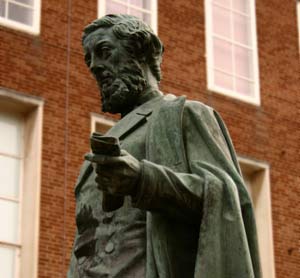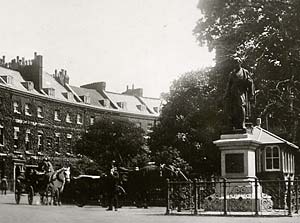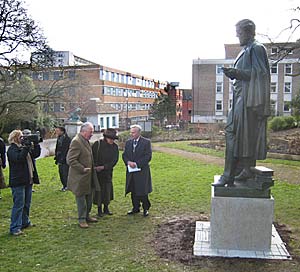
Statue of William Reginald Courtenay
Page updated 10th February 2010
Standing in Bedford Street was the most prominent statue of William Reginald Courtenay, the 11th Earl of Devon who was born in 1807, and died 1888. The Courtenay's have been a prominent family in Exeter for centuries, with Rougemont Castle held by Robert Courtenay in 1217. Relations between the Courtenay's and the city were always delicate due to their control of the Port of Topsham and attempts to cut off Exeter quay from the sea, by constructing Countess Wear. The weir was built by Isabella de Fortibus, Countess of Devon and her successor, Hugh Courtenay.
The family's fortune took a knock when Henry Courtenay was accused of treason by Henry VIII and was executed in 1539. The Courtenay's lost their possessions to the crown and were ordered to remove their obstructions from the river at Countess Wear. This was not practical so the city obtained permission to build the first pound lock canal in the country.
The 11th Earl of Devon William Reginald Courtenay was educated at Westminster College and Christchurch, Oxford, obtaining a Bachelor of Law. He became the Conservative Member of Parliament between 1841 and 1849 for South Devon. After he became the 11th Earl, in 1859 and succeeding his father in the House of Lords, he was Chancellor of the Duchy of Lancaster, President of the Poor Law Board, and was Honorary Colonel of the Royal 1st Devon Yeomanry Cavalry. He was a director of the Bristol and Exeter Railway, and was known as "The Good Earl" for his support of many charitable causes in Devon.
The statue was unveiled in 1880, by Sir Stafford Northcote in the presence of the Mayor and Corporation, and leading dignitaries of the day, including the Earl of Devon. The statue was paid for by a public subscription through The Devon Statue Fund and was sculpted by E B Stephens ARA, a native of Exeter, who also sculpted the Deer Stalker in Northernhay Park. It was positioned at the front of the central garden of Bedford Circus, on a site that had been occupied by Stephens glorious Deer Stalker Statue. On the rear of the pedestal, of Cornish granite from the Cheeswring Quarries, is a bronze plaque with the lines of Wordworth's Happy Warrior:
"Who, not content that former worth stand
fast,
Looks forward,
persevering to the last,
From
well to better, daily self-surpast."
After the ceremony, the guests, along with the Earl of Devon, attended a banquet, where Sir Stafford Northcote presented an album containing the names of 1,300 subscribers towards the statue.
The bombing of May 1942 destroyed Bedford Circus, but the Courtenay statue miraculously survived. It was put into storage, at Tan Lane, after the war, before being re-installed in Bedford Street during the 1950s. A plaque on the front stated:
"This statue stood in
Bedford Circus
prior to World War II.
The statue was erected on this site by
Exeter
City Council and Devon County Council
as part of a joint
landscaping scheme."
When the post office and shops in Bedford Street were demolished in 2005 for the Princesshay Development, the statue was removed and stored in the council yard at Belle Isles. The statue was restored by Ian Clarke Restoration, some ancient graffiti removed, before it was placed in the eastern part of Northernhay Park. Sally Blatch, a sharp eyed librarian, who saw the statue the week before the unveiling, noticed that Courtenay was misspelt, requiring the granite base to be hastily re-engraved. It was unveiled by the Lord Mayor, John Winterbottom, on 9th February 2010, attended by a small audience including the present Earl of Devon, Lord Courtenay.
Source: The Times 9 October 1880 and Express & Echo
 The statue
in Bedfrord Street, before it was removed.
The statue
in Bedfrord Street, before it was removed.

 The unveiling of the Earl of Devon
statue in Northernhay Park 9th February 2010. Courtesy of Paul Osborne,
Exeter City Council.
The unveiling of the Earl of Devon
statue in Northernhay Park 9th February 2010. Courtesy of Paul Osborne,
Exeter City Council.
│ Top of Page │